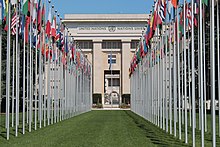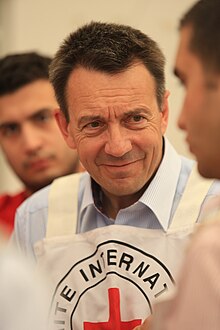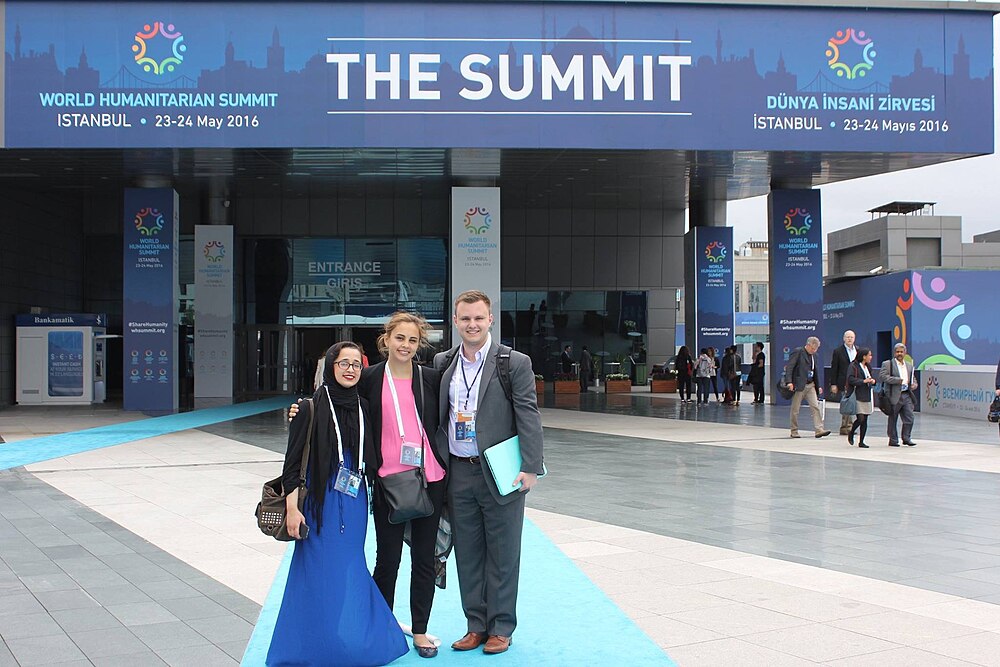Grand Bargain (humanitarian reform)
The Grand Bargain, sometimes called The Grand Bargain: Agenda for Humanity, was a set of 51 commitments made by governments and humanitarian aid agencies at the World Humanitarian Summit in May 2016.[1][2][3] Thirty world governments initially signed up to the Grand Bargain, committing to reform their spending on humanitarian aid.[1]
After complicated negotiations,[4] an agreement was made to reform humanitarian aid spending in ten focus areas.[1]
By 2020, only partial progress had occurred,[2] prompting criticism from some and reflection from others that the original ambitions were unrealistic in the time frame.[2]
Negotiations for a second set of agreements, the Grand Bargain 2.0, started in 2021.[2]
Background[]

As part of his 2012 goal to improve the humanitarian system, United Nations Secretary-General Ban Ki-moon convened the World Humanitarian Summit in Istanbul during 2016 with the goal of knowledge sharing and creating best practices.[5] At the summit, the High-Level Panel on Humanitarian Financing group presented their report Too important to fail - addressing the humanitarian financing gap. The report spoke of a US$15 billion shortfall between the cost of addressing humanitarian needs and the global budget to respond. The report called for new ways to fund growing humanitarian needs, such as taxation for luxury goods and services.[6][7][8] The group's report called for a Grand Bargain between nations to address the unmet humanitarian needs.[9]
Negotiations[]
The negotiation process was described in The New Humanitarian as “messy”, “disjointed”, and “incredibly bureaucratic”.[4] The negotiating governments had logistical challenges with the calls to adjusting funding traditions in which the majority of government aid spending goes directly to United Nations agencies.[1]
Negotiations between governments at the World Humanitarian Summit was heated and the final commitments were diluted, for example the degree of enthusiasm to disburse cash in humanitarian relief, due to the US Government's preference to give tangible aid items.[1][10]
Focus areas[]
The 2016 Grand Bargain has 51 specific commitments grouped into ten focus areas:[1]
- Transparency - a commitment to “publish timely, transparent, harmonised and open high-quality data on humanitarian funding within two years”
- Local spending - a commitment to increase spending on local organizations from 0.4% of the overall budget to 25% by 2020. In subsequent years, this effort became known as Localisation.
- Use of cash - conflicting statements were made simultaneously mentioning the benefits of giving people with humanitarian needs cash, but also calling for more research.
- Reduction of duplication and management costs - a commitment to harmonize the templates for grant agreements between government donors and humanitarian agencies
- Needs assessments - the call for unification of assessments of unmet humanitarian needs, was criticized by ACAPS for not addressing the necessary changes
- Inclusion - a commitment to better include the perspectives of the people in communities affected by humanitarian crisis
- Multi-year funding - a target to provide aid agencies with agreements to fund their activities for multiple years at a time, rather than requiring annual requests for funding
- Earmarking - a commitment to put more funding into emergency funds, such as the Central Emergency Relief Fund, in order to increase flexibility of how funds can be used in emergencies.
- Reporting - a commitment by government donors to harmonize the reporting requirements they put on humanitarian agencies by 2018, and reduce the reporting volume
- Coordination - Improved collaboration between groups working on prevention of humanitarian crisis, those working on mitigating the effects of crisis and those responding to emergencies
In addition to improving the humanitarian system, the commitments were expected to save US$1 billion per year.[1][11]
Each of the ten focus areas has two co-conveners, a government donor and a humanitarian aid agency who report into a facilitation group that coordinates the work between the ten focus areas.[4] The administration of the process is done by the Directorate-General for European Civil Protection and Humanitarian Aid Operations.[4]
Signatories[]

30 governments and aid agencies signed up to the Grand Bargain initially, and a further 18 had joined by March 2017.[4] In 2016, the 48 controlled 95% of global spending on humanitarian aid.[12] By December 2021, 64 organizations had signed up.[13]
Government signatories included USA, UK, Germany, France and Japan; aid agency signatories included International Federation of Red Cross and Red Crescent Societies.[11]
Aid agency, Medecins Sans Frontieres, notably did not sign the agreement, criticizing the process for its non binding commitments, a decision itself that was criticized as "cynical" by Nancy Lindborg of the United States Institute of Peace.[3]
Critical reception in 2016[]

In 2016, the Grand Bargain was met with a mixture of enthusiasm, pragmatic caution, and dismay.[1] Lilianne Ploumen pointed out how difficult it is to get multiple governments to all agree to big changes. The Overseas Development Institute criticized the Grand Bargain for its similarity with the status quo, pointing out a need for more specific targets and timelines.[1] Colin Bruce of the World Bank said that the agreement was owned by no-one and stressed the importance of following up on the commitments.[1] Peter Maurer of the International Committee of the Red Cross praised the focus on reducing reporting to donor governments.[1]
Andras Derzsi-Horvath and Julia Steets of the Global Public Policy Institute published an op-ed in DW News criticizing the Grand Bargain for having only voluntary obligations.[14]
Progress towards commitments and critique in the 2020s[]
In 2021, The New Humanitarian reported that many of the 51 commitments had only been partly met.[2]
Wendy Fenton of the Humanitarian Practice Network and Overseas Development Institute said that the 51 commitments were too much to have attempted in five years.[2]
A June 2021 independent review of the Grand Bargain by the Overseas Development Institute praised the progress towards policy shifts around provision of cash assistance, increasing funding to local aid groups, harmonized needs assessments and reporting. It was noted that the policy had a lower impact on actual practice.[15] The Overseas Development Institute review criticized the way the transparency commitments were written, noted the lack of global agreement on how to distribute cash to people in need, and lamented the poor progress towards cost savings. The review reported a lack of political interest in including the perspectives of the people living in humanitarian crises in designing emergency responses.[15]
UK-based group Development Initiatives reported in 2021 that the percentage of funding going to local organizations between 2016 and 2020 actually reduced from 3.5% to 2.1%.[16][17][18]
Degan Ali, of Adeso writing in OpenDemocracy in 2020, described the Grand Bargain as a "failed effort".[19]
Grand Bargain 2.0[]

In 2021, sixty donors started new negotiations to create an updated Grand Bargain 2.0 that will cover 2020 to 2023.[2] Grand Bargain 2.0 focuses on greater support to local humanitarian agencies, improved participation of people from communities affected by humanitarian crisis and more flexible funding to aid agencies.[2]
The June 2021 meeting to agree details was led by Jan Egeland, of the Norwegian Refugee Council.[2]
The Grand Bargain 2.0 agreement attempts to address concerns raised about the original agreement with a focus on an improved consultation process with local organizations.[20]p. 36
See also[]
- UN Office for the Coordination of Humanitarian Affairs
- Network for Empowered Aid Response
- Interrogating the evidence base on humanitarian localisation (2021 report)
References[]
- ^ a b c d e f g h i j k Parker, Ben (2016-05-24). "Is the Grand Bargain a Big Deal?". The New Humanitarian. Retrieved 2021-12-27.
{{cite web}}: CS1 maint: url-status (link) - ^ a b c d e f g h i Alexander, Jessica (2021-06-10). "A renewed push to make aid more efficient". The New Humanitarian. Retrieved 2021-12-27.
{{cite web}}: CS1 maint: url-status (link) - ^ a b Kenyon, Peter (24 May 2016). "The World Promises To Do A Better Job Aiding Refugees From Violence". www.wbur.org. Retrieved 2021-12-27.
{{cite web}}: CS1 maint: url-status (link) - ^ a b c d e Redvers, Louise (2017-03-22). "Hunting for the Grand Bargain". The New Humanitarian. Retrieved 2021-12-27.
{{cite web}}: CS1 maint: url-status (link) - ^ Ki-Moon, Ban (25 Jan 2012). "THE SECRETARY-GENERAL'S FIVE-YEAR ACTION AGENDA" (PDF). United Nations.
{{cite web}}: CS1 maint: url-status (link) - ^ "High-Level Panel on Humanitarian Financing Report to the Secretary-General: Too important to fail - addressing the humanitarian financing gap". ReliefWeb. Retrieved 2021-12-27.
- ^ Esslemont, Tom (2016-01-17). "Get Uber, FIFA and rich Muslims to help plug aid gap- experts". Reuters. Retrieved 2021-12-27.
- ^ Mosselmans, Michael (2016-02-05). "Only a fraction of humanitarian aid goes through local organisations. Why?". the Guardian. Retrieved 2021-12-27.
- ^ Redvers, Louise (2016-01-18). "UN aid panel calls for 'grand bargain' on finance". The New Humanitarian. Retrieved 2021-12-27.
{{cite web}}: CS1 maint: url-status (link) - ^ Johnson, Erik; Baizan, Paula Gil (2016-06-27). "What people in humanitarian crises need is cash, not commodities". the Guardian. Retrieved 2021-12-27.
- ^ a b "First day of Humanitarian Summit ends with 'grand bargain'". TRT World. 24 May 2016. Retrieved 2021-12-27.
{{cite web}}: CS1 maint: url-status (link) - ^ "Governmental funding for humanitarian aid 2016 ($ m)". datawrapper.dwcdn.net. Retrieved 2021-12-27.
- ^ "The Grand Bargain Signatories Last update: December 2021" (PDF). Inter Agency Standing Committee. Dec 2021.
{{cite web}}: CS1 maint: url-status (link) - ^ Steets, Julie; Derzsi-Horvath, Andras (2016-05-24). "Old habits die hard at World Humanitarian Summit". DW. Retrieved 2021-12-27.
{{cite web}}: CS1 maint: url-status (link) - ^ a b Metcalfe-Hough, Victoria; Fenton, Wendy; Willitts-King, Barnaby; Spencer, Alexandra (2021). The Grand Bargain at five years - An independent review (PDF). Overseas Development Institute.
- ^ The Editorial Board (2021-02-13). "Opinion | Foreign Aid Is Having a Reckoning". The New York Times. ISSN 0362-4331. Retrieved 2021-12-27.
- ^ Mwaura, Gitura (2021-02-21). "Does Africa need foreign aid?". The New Times | Rwanda. Retrieved 2021-12-27.
{{cite web}}: CS1 maint: url-status (link) - ^ "Funding for effectiveness and efficiency". Development Initiatives. Retrieved 2021-12-28.
- ^ Ali, Degan; Murphy, Marie-Rose Romain (19 July 2020). "Black Lives Matter is also a reckoning for foreign aid and international NGOs". openDemocracy. Retrieved 2021-12-27.
{{cite web}}: CS1 maint: url-status (link) - ^ Robillard, Sabina; Atim, Teddy; Maxwell, Daniel (December 2021). "Localization: A "Landscape" Report" (PDF). Tufts University.
Further reading[]
- Too important to fail—addressing the humanitarian financing gap, the report that recommended the Grand Bargain
- Global Humanitarian Overview 2021, United Nations Office for the Coordination of Humanitarian Affairs
- The State of the Humanitarian System, ALNAP
External links[]
- Humanitarian aid
- United Nations
- Globalization
- International development multilaterals
- International development
- Foreign policy
- Global politics
- 2016 in Turkey
